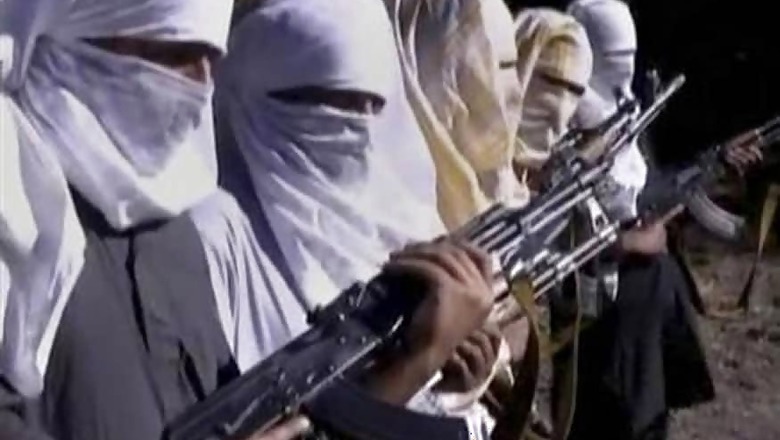
views
Kabul: Eleven Taliban commanders have been released from a high-security prison in Afghanistan, according to Taliban officials, in an apparent deal that included a prominent regional leader caught five years ago personally escorting a shipment of nearly a ton of opium.
Afghan and US officials have remained silent about the releases from the prison, near the Bagram Air Base outside Kabul. A senior Afghan official said the 11 Taliban prisoners had been released in return for three Indian engineers after months of negotiations with local Taliban commanders in northern Baghlan province, where the engineers were kidnapped last year. The Indian Embassy in Afghanistan declined to comment.
The releases, which took place Sunday, came just days after Zalmay Khalilzad, the US diplomat and chief negotiator with the Taliban, went to Islamabad, Pakistan, and met with Taliban representatives. It was Khalilzad’s first meeting with them since President Donald Trump called off negotiations with the insurgents on the eve of a potential breakthrough.
The potential release of thousands of Taliban prisoners was part of those negotiations. But that issue was a main point of contention with Afghan officials who were furious that their government was excluded from those talks and that the United States was negotiating the release of prisoners being held under Afghan authority.
It was unclear whether the releases Sunday had anything to do with negotiations between the United States and the Taliban. In Afghanistan, however, rumors were rife — not only among Afghan and Taliban officials, but also some diplomats — that a separate prisoner exchange had been a major topic of discussion in the Islamabad meeting between the Khalilzad and the Taliban.
The insurgents have been holding three American University of Afghanistan professors since August 2016, one of them an American said to be in poor health. In return for their release, the Taliban have demanded the release of Anas Haqqani, a member of the feared Haqqani network, a wing of the Taliban. He is a stepbrother of the network’s leader and is one of the most prized prisoners of the Afghan government.
Some Afghan and Taliban officials suggested the two sides might have reached an agreement on the swap, possibly as a trust building measure that could help revive the broader peace negotiations.
The release of prisoners in itself was not unusual, with the Afghan government on occasions of religious festivals often pardoning dozens whose prison terms are near completion
But what has drawn attention to this latest release is the notoriety of one Taliban figure in particular: Abdul Rashid Baluch, who was on the US Treasury Department’s “Specially Designated Global Terrorist” list and was arrested in a narcotics raid five years ago.
Baluch was a Taliban shadow governor, a regional official in charge of military and political operations in the southwestern province of Nimroz, when he was caught with a huge shipment of opium. The drug bust was held up as a major revelation in how the line between Taliban insurgents and the narcotics mafia had blurred in Afghanistan. (Taliban officials have denied that. Baluch was involved in drug trafficking.)
Despite evidence of Baluch’s involvement in terrorist attacks, Afghan prosecutors deliberately tried him on stricter counternarcotics charges. They feared that the counterterrorism process was vulnerable to political deal-making.
Now, the release of Baluch, especially if it is tied to the US peace talks with the Taliban, once again brings to the fore the concern that the US negotiations did not address the complexity of the conflict — and particularly how to consider the Taliban’s increasing hold on the massive drug trade in the country.
If his release was a unilateral Afghan government decision, it is unlikely that the Afghan government would decide on the fate of a US-designated terrorist figure without first consulting the Americans.
Baluch was arrested in Nimroz, a smuggling hub on the border with Iran, in July 2014. An Afghan special forces helicopter swooped down on two vehicles racing through the desert, seizing nearly a metric ton of opium, light and heavy weapons, ammunition and satellite phones. The main person they detained had insisted he was a carpet seller, giving his name as Muhammad Eshaq, but investigators confirmed his identity as Abdul Rashid Baluch when he was transferred to Kabul, the Afghan capital.
Both Afghan and Western officials at the time played up his case, and his arrest in a counternarcotics operation rather than a counterterrorism raid. He was tried in the country’s high-security drug court and given an 18-year sentence.
His release now, under circumstances lacking transparency, is the latest instance of a major drug smuggler going free.
Late in 2014, Hajji Lal Jan Ishaqzai, another major kingpin, bribed his way out of prison by paying millions of dollars. Long among wanted international smugglers, he had been arrested in 2012 after a shootout and sentenced to 20 years in prison.
The United States has spent more than $8 billion on narcotics operations in Afghanistan, according to the US Special Inspector General for Afghanistan Reconstruction. Throughout the course of the war, American officials have shifted anti-drug strategies several times.
Earlier this year, the US-led mission in Afghanistan called off its latest attempt to cut off the Taliban’s revenue stream from drugs: a concerted bombing campaign that targeted drug labs, mostly in the country’s volatile south where much of the opium is grown. In 2018, the total opium poppy cultivation area in Afghanistan was estimated at between 242,000 to 283,000 hectares, according to a United Nations report, the second-highest measurement since it started monitoring the crop in 1994.
When the Taliban was in power in the 1990s, the group largely prohibited poppy cultivation. After the American-led invasion in 2001, the government-turned insurgent group turned to the opium trade for financial support.
In an unrelated incident Monday, an explosion in the eastern city of Jalalabad killed 10 people and wounded 27 others, said Attaullah Khogyani, the spokesman for the governor of Nangarhar province. Most of the casualties were newly recruited soldiers aboard a shuttle bus caught in the blast.
Mujib Mashal
c.2019 The New York Times Company




















Comments
0 comment